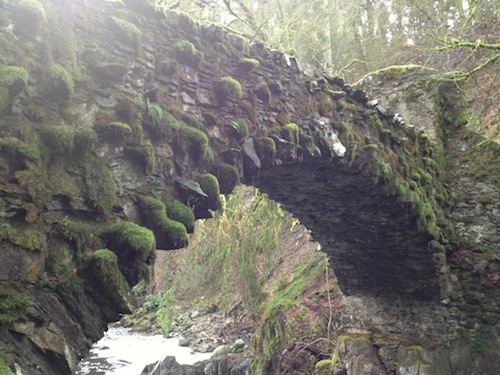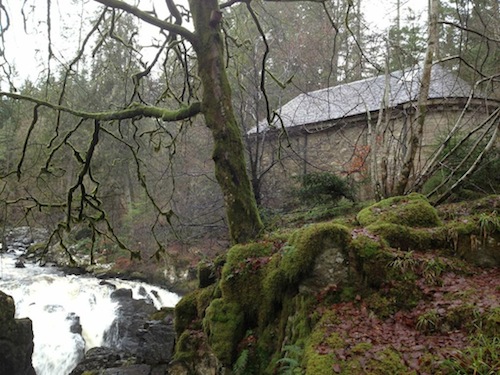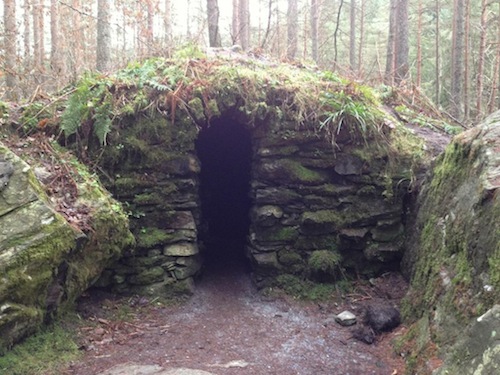
(Image credit: Jay Voss)
About a month ago I was fortunate enough to find myself outside of Ossian’s hall. I was on the banks of the River Braan in Craigvinean Forest, just to the west of Dunkeld, Scotland. Crazier still, though I’m writing a dissertation concerning the Scottish Enlightenment, I hadn’t set out that morning to find where Ossian came from. I was just in the area doing a bit of hiking (or “hill walking,” rather), and on the last day I set out for something I’d been told by a local that I just had to see. He called it “The Hermitage”. What I was to discover that morning was a pleasure garden designed in the later half of the eighteenth century for the Dukes of Atholl. So I set out from Dunkeld on a mulch path next to the strong River Tay, and about a mile and a half from town where the River Braan enters the River Tay I headed up into the hills and entered the Craigvinean Forest, which is a beautiful old-growth swath of Douglas firs. As I was soon to discover, what was crazy about the pleasure garden, and thus why I think it might be fun to present it here, was that it is a visual representation of the immediate fanfare that surrounded James Macpherson’s eighteenth-century cycle of epic poems.

(Image credit: Jay Voss)
These days modern readers really get hung up on the fact that Macpherson’s Ossian cycle is largely fabricated, but back in the day the work was an international literary sensation. Such esteemed readers as Thomas Jefferson, Napoleon Bonaparte, and the young Walter Scott were huge fans. (OK, Napoleon isn’t necessarily known for his delicate literary tastes, but nevertheless you get the idea about Macpherson’s reach.) The first structure I came across in the pleasure garden was the actual Hermitage (seen above). It was built in 1757 by the 2nd Duke of Atholl as a viewing station for the gorgeous Black Linn falls that lie below. In the course of later additions to the garden (during the early 1780s) the space was dedicated as a shrine to Ossian. The interior space was then lined with mirrors, which reflect the Black Linn falls’ light in an amazing way. I do not have a photograph of this effect to share, unfortunately, as the overall lighting in the space wasn’t kind to my iPhone’s aperture, but suffice it to say that William Wordsworth wrote a couple poems while stopping in this room in 1803.

(Image credit: Jay Voss)
Further back in the garden one can find Ossian’s cave, seen above. It isn’t so much a cave as an igloo made of rocks, but the literary fan in me couldn’t help but be delighted. This structure was constructed in 1760 by the third Earl of Breadalbane. What a better way to celebrate the blind poet Ossian than with this lovely cave? The limited capacity of the blog genre doesn’t necessarily allow me the space here to expound on this garden’s aesthetic heritage, but in closing I’d like to say that Ossian is really perfect subject matter for a garden. Gardens, and particularly eighteenth-century gardens, are explorations of the extent to which man can control nature, or the extent to which man can play with nature to produce something that seems more natural than what was originally there. Throughout the eighteenth century, man’s ability to shape nature on grand scales was considered to be a testament of human progress. (One only needs to think of André Le Nôtre’s design of the Champs-Élysées for an example of this.) How to design a wilderness in tribute to an ancient blind poet of the Scottish highlands?
Keep it wild and place a nice waterfall in view.
Recent comments
2 years 29 weeks ago
2 years 44 weeks ago
2 years 44 weeks ago
2 years 50 weeks ago
3 years 4 weeks ago
3 years 4 weeks ago
3 years 4 weeks ago
3 years 6 weeks ago
3 years 6 weeks ago
3 years 6 weeks ago